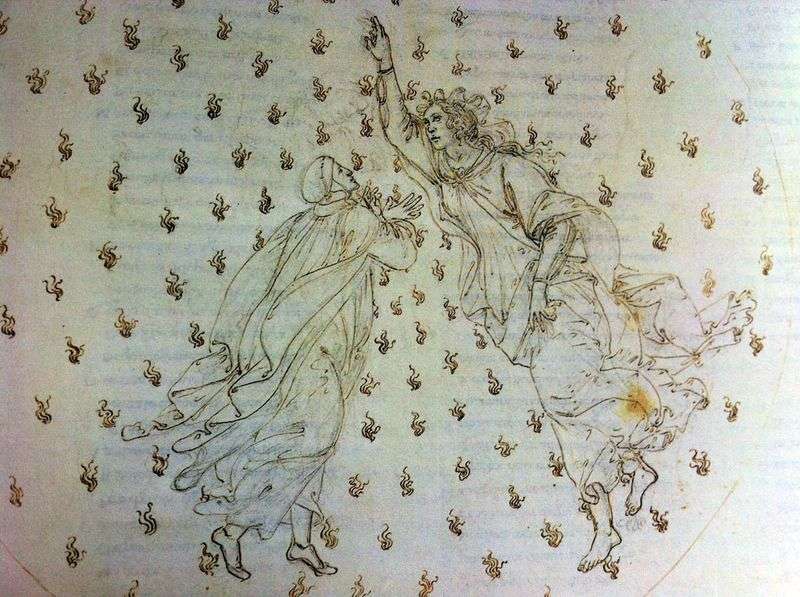
Botticelli’s approach to illustrating “Paradise” is surprising in its novelty. The artist rejects the modern tradition of unfolding the narrative line of the text. He gives only a summary of the song, concentrating its content in the laconic expressiveness of two figures, Dante and Beatrice, imprisoned in the circle of the sky.
In the illustrations to “Paradise” almost all the plane of the sheet is filled with the figures of Dante and Beatrice, and their infinitely recurring dialogue reveals the subtlest shades of feeling: joyful impulse, faith, embarrassment, reproach, admiration; live, impetuous strokes of lines on an unfilled white background create a feeling of joyful vibration, fullness of light with the whole space. The power of the impact of the drawings in the suggestibility of the images of “Paradise”. The almost intangible outlines of the circle convey a sense of light-air infinity. The tongues of the flame of souls, arising from the fluttering ornamental curls, reflect the sound of the heavenly light. The artist shows a glimpse of paradise visions in the figures of travelers, in their facial expressions, the consistency of movements, the game of folds of their clothes.
And one more feature appears in the last drawings of the series: Beatrice, this embodiment of beauty, ugly and almost two heads above Dante! There is no doubt that, with this large-scale difference, Botticelli sought to convey the greater importance of Beatrice’s image and, perhaps, the sense of her superiority and her own insignificance, which Dante experienced in her presence. The problem of the balance of beauty of the physical and spiritual constantly stood before Botticelli, and he tried to solve it, giving the pagan and beautiful body of his Venus the face of the meditative Madonna. Beatrice’s face is not beautiful, but she has amazingly beautiful, big and quiveringly spiritualized hands and some special impetuous grace of movements.
In the picture illustrating the Song of the Thirtieth of the “Divine Comedy”, Botticelli depicted how Dante and Beatrice ascended along the river of light to the Empire – the highest heavens. In the stream of light frolic little little putti, then dive into the blossoming thickets on either side of the river of light. The right part of the picture is just a sketch with a silver pencil, not retouched with ink.
I became both power and support, Advertising: “From the body of the higher podyaty We are in pure light.” And it was said by the signora: “The light of the intellect, the rich love, the Love for the good, whose faces are immeasurable, the faces that you will not find pleasurable. And as if the lightning strikes the sight, So that it fades and is indistinguishable Already and more vividly vivid, So I was enveloped by the light of the living And everything else hid the curtains of the Shining, in which everything that is visible is extinguished.
The meaning of the “Comedy” is intertwined with the Neoplatonic conception of the highest world of manifestation of supersensible beauty, where the soul, free from corporeal captivity, rises through contemplation of the steps of the divine emanation to the original and final Oneness.
